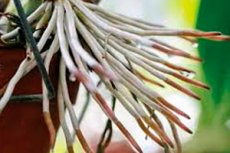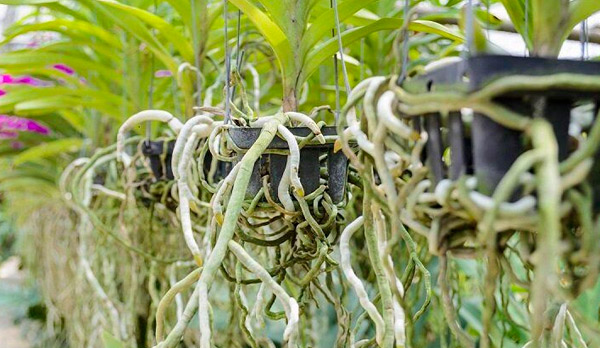Orchid root modifications
Last reviewed: 11.03.2025

Orchids are fascinating plants, and one of their most unique features is the modification of their roots. But what exactly is the name of the root modification in orchids, and what type of root modification do orchids have? In this article, we will explore the root modifications characteristic of orchids and their functions, as well as why these adaptations are crucial for the plant's survival in its natural habitat.
What are orchid root modifications?
Orchids belong to the epiphytic group of plants, which means they grow on other plants, often on trees. As a result, their roots have undergone several modifications to adapt to their unique environment. The name of the root modification in orchids is called "aerial roots." these roots are specialized and are designed to support the orchid in ways that are very different from typical terrestrial plant roots.
What Are Aerial Roots?
Aerial roots are roots that grow above the ground, exposed to air rather than being buried in soil. This type of root modification allows orchids to absorb moisture and nutrients directly from the air, which is especially useful in their native rainforest environments, where they grow attached to the bark of trees. What type of root modification does an orchid have? The answer lies in these specialized aerial roots that perform multiple vital functions.
Aerial roots are a unique feature of epiphytic orchids, such as Phalaenopsis, Vanda, and Dendrobium. These roots allow the plants to efficiently anchor themselves to trees, absorb moisture and nutrients from the air, and sometimes even contribute to photosynthesis. Understanding their functions and proper care will help maintain the health of your orchid.

Aerial roots are specialized orchid roots that grow outside the substrate. Their main characteristics include:
- Velamen coating: The outer layer of dead cells that absorbs moisture from the air.
- Functions: Securing the plant, absorbing moisture, and participating in photosynthesis (in some species).
- Appearance: Thick, elongated, gray-green, or whitish.
Primary Functions of Aerial Roots
- Water and nutrient absorption:
Aerial roots absorb moisture from rain, dew, and ambient air. - Anchoring:
Help the orchid attach to trees, rocks, or other supports in natural habitats. - Photosynthesis:
In some orchids, aerial roots contain chlorophyll, enabling them to perform photosynthesis.
Caring for Aerial Roots
-
Watering:
- Regularly mist roots with soft water (rainwater or settled tap water).
- Prevent the roots from completely drying out.
-
Inspection:
- Check roots for signs of damage, rot, or disease.
- Trim dry or rotting roots with sterile scissors and treat the cut with crushed charcoal.
-
Temperature and Humidity:
- Maintain air humidity at 50–70%.
- Avoid temperature fluctuations and dry air.
-
Lighting:
- Ensure aerial roots receive indirect light.
- Protect them from direct sunlight to prevent burns.
-
Fertilizing:
- During watering, add weak concentrations of fertilizer to provide nutrients for the roots.
Common Problems with Aerial Roots
-
Dry roots:
- Causes: Lack of moisture, dry air.
- Solution: Increase misting frequency and humidity levels.
-
Root rot:
- Causes: Overwatering, poor ventilation.
- Solution: Trim damaged areas and repot the plant in fresh substrate.
-
Dark spots or cracks:
- Causes: Sunburns or mechanical damage.
- Solution: Protect roots from direct sunlight and handle the plant carefully.
Can Aerial Roots Be Trimmed?
-
Permitted:
Only dry, damaged, or rotten roots should be removed.
Use sterile tools for trimming, and treat the cuts with charcoal or fungicide. -
Not Recommended:
Removing healthy aerial roots, as it disrupts the plant's ability to absorb moisture and nutrients.
Aerial Roots in Nature and Indoors
-
In natural habitats:
- Orchids grow as epiphytes, with their aerial roots interacting with the environment.
- Nutrients are absorbed from decomposing organic matter.
-
In indoor environments:
- Aerial roots often extend beyond the pot, which is normal.
- They adapt to home conditions if humidity and light are adequate.
Useful Tips
- Repotting:
During repotting, do not force aerial roots into the pot, as this can damage the plant. - Additional support:
For long and fragile roots, use supports to secure them. - Monitor root health:
Healthy aerial roots should be firm and green when hydrated.
Types of root modifications characteristic of orchids
The root modifications characteristic of orchids can be classified as follows:
- Velamen layer: one of the most distinctive features of orchid roots is the presence of a velamen layer. Velamen is a thick, spongy layer that covers the aerial roots, acting as a protective shield and aiding in the absorption of water and nutrients from the environment. This layer also helps to prevent moisture loss, which is essential for orchids growing high up in trees, exposed to the elements.
- Photosynthetic roots: another significant modification is that many orchid roots are capable of photosynthesis. In other words, these roots contain chlorophyll, allowing them to carry out photosynthesis and produce energy. This is an important adaptation for orchids, as it enables them to generate additional nutrients when their leaves receive limited light due to the dense rainforest canopy.
- Attachment mechanism: the roots of orchids are also adapted to anchor the plant firmly to tree bark or rocks. The modified root structure allows orchids to cling to various surfaces, providing stability and support even in windy conditions. This feature is crucial for orchids, which often grow in precarious positions high above the ground.
Why are orchid root modifications important?
These adaptations are vital for the plant's survival in its natural habitat. Orchids often grow in environments where traditional soil-based root systems are not possible. Instead, they have adapted to obtain their nutrients and moisture from the air, rain, and debris that accumulates on the surface they are attached to.
The velamen layer is particularly important, as it not only helps in absorbing water but also acts as insulation, protecting the roots from dehydration during periods of low humidity. This adaptation is one reason why orchids can thrive in challenging environments where water may not always be readily available.
Additionally, the ability of the roots to photosynthesize is a significant advantage. In the dense rainforest canopy, light is often a limiting factor, and orchids must take advantage of every possible source of energy. By allowing their roots to photosynthesize, orchids maximize their ability to generate energy, increasing their chances of survival.
How do orchid root modifications affect care in cultivation?
Understanding the modification of orchid roots is key to providing proper care in a home environment. When growing orchids in cultivation, it is important to remember that their roots are not meant to be completely buried in soil. Instead, they need a well-aerated growing medium, such as bark or sphagnum moss, which mimics their natural environment and allows the roots to breathe.
Many orchid enthusiasts are concerned when they see aerial roots growing out of the pot. However, these roots are a natural part of the plant's adaptation and should not be removed. Instead, they should be allowed to grow freely, as they play a crucial role in moisture and nutrient absorption.
Proper watering is also essential for orchid care, given the unique structure of their roots. Orchid roots are highly susceptible to root rot if they are left in standing water for too long. Therefore, it is important to allow the growing medium to dry out between waterings to prevent damage to the roots.
Conclusion
The root modifications of orchids are a fascinating example of how plants adapt to their environment. The aerial roots, velamen layer, and photosynthetic capabilities are all modifications that allow orchids to thrive in the challenging conditions of their native habitats. By understanding what type of root modifications orchids have, you can better appreciate their unique characteristics and provide the care they need to flourish.
Whether you are a beginner or an experienced orchid grower, recognizing the importance of these root modifications will help you create an environment that supports healthy growth and beautiful blooms. Remember, the key to successful orchid care is to respect the plant's natural adaptations and provide conditions that allow these amazing roots to do their job effectively.
